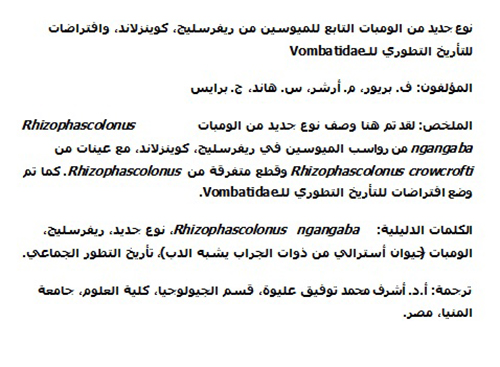A new species of Miocene wombat (Marsupialia, Vombatiformes) from Riversleigh, Queensland, and implications for the evolutionary history of the Vombatidae
Plain Language Abstract
A new species of wombat is described from limestone deposits in the Riversleigh World Heritage Area of Queensland, and is estimated to be approximately 18 million years old (early Miocene). Additional specimens attributable to species of Rhizophascolonus (a genus of wombat otherwise known only from three isolated teeth from South Australia) are also described from Riversleigh. An analysis was run to find the simplest way these species could be related to each other based on the shape of their teeth and bones. The results of this analysis indicated that Rhizophascolonus crowcrofti is the next most primitive wombat after Nimbavombatus boodjamullensis (known from similarly-aged deposits at Riversleigh). Similarities between the teeth of Nimbavombatus and Rhizophascolonus suggest that adaptations to high rates of tooth wear in wombats had their origin in the late Oligocene (i.e., prior to 23 million years ago), presumably in response to cooling of the climate, which happened at that time and its effects on the vegetation. A period of climatic amelioration in the early Miocene (between 26 and 16 million years ago) may have led to diversification of wombats or to an expansion of their range into rainforest habitats. Although wombats form a significant component of Australia’s open-forest and woodland habitats from the early Pliocene to Holocene (from around 5 million years ago to the present), they appear to have been rare prior to this.
Resumen en Español
Una nueva especie de wómbat mioceno (Marsupialia, Vombatiformes) de Riversleigh, Queensland, e implicaciones para la historia evolutiva de los Vombatidae
Una nueva especie de wómbat, Rhizophascolonus ngangaba sp. nov., se describe a partir de los depósitos del Mioceno en Riversleigh junto con especímenes adicionales de Rhizophascolonus crowcrofti, y algunos fragmentos maxilares y mandibulares atribuibles a Rhizophascolonus. El análisis filogenético indica que Rhizophascolonus es el siguiente wómbat más plesiomórfico después de Nimbavombatus boodjamullensis. Los caracteres morfológicos comunes a Nimbavombatus y Rhizophascolonus sugieren que las adaptaciones a las altas tasas de desgaste dental en los wómbats tuvieron su origen en el Oligoceno tardío, presumiblemente en respuesta al enfriamiento climático y sus efectos sobre la vegetación. Un período de mejora climática en el Mioceno temprano pudo haber conducido a la diversificación de los wómbats y/o a una expansión de su rango dentro de los hábitats de selva tropical. Aunque los wómbats forman un componente significativo de los hábitats boscosos y de bosques abiertos de Australia desde el Plioceno temprano hasta el Holoceno, parece que fueron escasos en todos los paleoambientes antes de dicha circunstancia.
Palabras clave: Rhizophascolonus ngangaba; nuevas especie; Riversleigh, wómbat; filogenia.
Traducción: Enrique Peñalver (Sociedad Española de Paleontología)
Résumé en Français
Une nouvelle espèce miocène de wombat (Marsupialia, Vombatiformes) de Riversleigh, Queensland : implications pour l’histoire évolutive des Vombatidae
Une nouvelle espèce de wombat, Rhizophascolonus ngangaba sp. nov., est décrite dans les dépôts miocènes de Riversleigh, avec également des spécimens de Rhizophascolonus crowcrofti, et des fragments de mandibule et de maxillaire attribuables à Rhizophascolonus. Une analyse phylogénétique indique que Rhizophascolonus est le wombat présentant le plus d’états de caractères plésiomorphes après Nimbavombatus boodjamullensis. Les caractères morphologiques communs entre Nimbavombatus et Rhizophascolonus suggèrent que les adaptations à des taux élevés d’usure dentaire chez les wombats sont apparues à l’Oligocène récent, probablement en réponse au refroidissement climatique et à ses effets sur la végétation. Une période d’amélioration climatique au Miocène ancien a pu causer la diversification des wombats et/ou l’expansion de leur répartition dans les habitats de forêts humides. Bien que les wombats constituent une composante importante des habitats de forêts ouvertes et de forêts en Australie du Pliocène ancien à l’Holocène, il semble qu’ils étaient rares dans tous les paléoenvironnements avant le Pliocène ancien.
Mots-clés : Rhizophascolonus ngangaba sp. nov. ; nouvelle espèce ; Riversleigh ; wombat ; phylogénie.
Translator: Antoine Souron
Deutsche Zusammenfassung
Eine neue Art eines miozänen Wombats (Marsupialia, Vombatiformes) aus Riversleigh, Queensland und Folgerungen für die Evolutionsgeschichte der Vombatidae
Die neue Wombat-Art Rhizophascolonus ngangaba sp. nov. aus miozänen Ablagerungen von Riversleigh wird zusammen mit zusätzlichen Stücken von Rhizophascolonus crowcrofti und einigen maxillaren und mandibulären Fragmenten, die Rhizophascolonus zugeschrieben werden können, beschrieben. Eine phylogenetische Analyse weist darauf hin, dass Rhizophascolonus der nächste plesiomorphe Wombat nach Nimbavombatus boodjamullensis ist. Gemeinsame morphologische Merkmale von Nimbavombatus und Rhizophascolonus legen nahe, dass Anpassungen an hohe Zahnabriebs-Raten bei Wombat ihren Ursprung im späten Oligozän hatten, vermutlich als Reaktion auf Klimaabkühlung und deren Auswirkungen auf die Vegetation. Eine Periode mit besserem Klima im frühen Miozän führte möglicherweise zur Diversifikation der Wombats und/oder zu einer Ausbreitung ihres Lebensraums hinein in Regenwälder. Obwohl Wombats eine wichtige Komponente der offenen Wälder und Waldgebiete Australiens vom frühen Pliozän bis zum Holozän darstellen, scheinen sie in allen Paläolebensräumen davor selten zu sein.
Schlüsselwörter: Rhizophascolonus ngangaba; neue Art; Riversleigh, Wombat; Phylogenie.
Translator: Eva Gebauer
Arabic

Translator: Ashraf M.T. Elewa
Polski
Nowy gatunek mioceńskiego wombata (Marsupialia, Vombatiformes) z Riversleigh, Queensland oraz implikacje do historii ewolucji dla Vombatidae
Nowy gatunek wombata, Rhizophascolonus ngangaba sp. nov., został opisany z osadów mioceńskich w Riversleigh wraz z współwystępującymi okazami Rhizophascolonus crowcrofti oraz z fragmentami szczęki i żuchwy przynależnymi do Rhizophascolonus. Analiza filogenetyczna wskazuje, że Rhizophascolonus jest kolejnym, najbardziej plesiomorficznym wombatem po Nimbavombatus boodjamullensis. Cechy morfologiczne, wspólne dla Nimbavombatus i Rhizophascolonus sugerują, że adaptacja przejawiająca się w wysokim wskaźniku zużycia zębów, u wombatów pochodzi z późnego oligocenu, prawdopodobnie w reakcji na klimatyczne ochłodzenie i powiązana z nim zmiana roślinności. Okres poprawy klimatu we wczesnym miocenie mógł doprowadzić do dywersyfikacji wombatów i / lub rozszerzenia ich zasięgu siedliska na lasy deszczowe. Chociaż wombaty stanowią istotny składnik otwartych lasów Australii, to siedliska leśne, od wczesnego pliocenu po holocen, wydają się być rzadkie wśród wszystkich wcześniejszych paleośrodowisk.
Słowa kluczowe: Rhizophascolonus ngangaba; nowy gatunek; Riversleigh, wombat; filogeneza.
Translator: Dariusz Nowakowski

